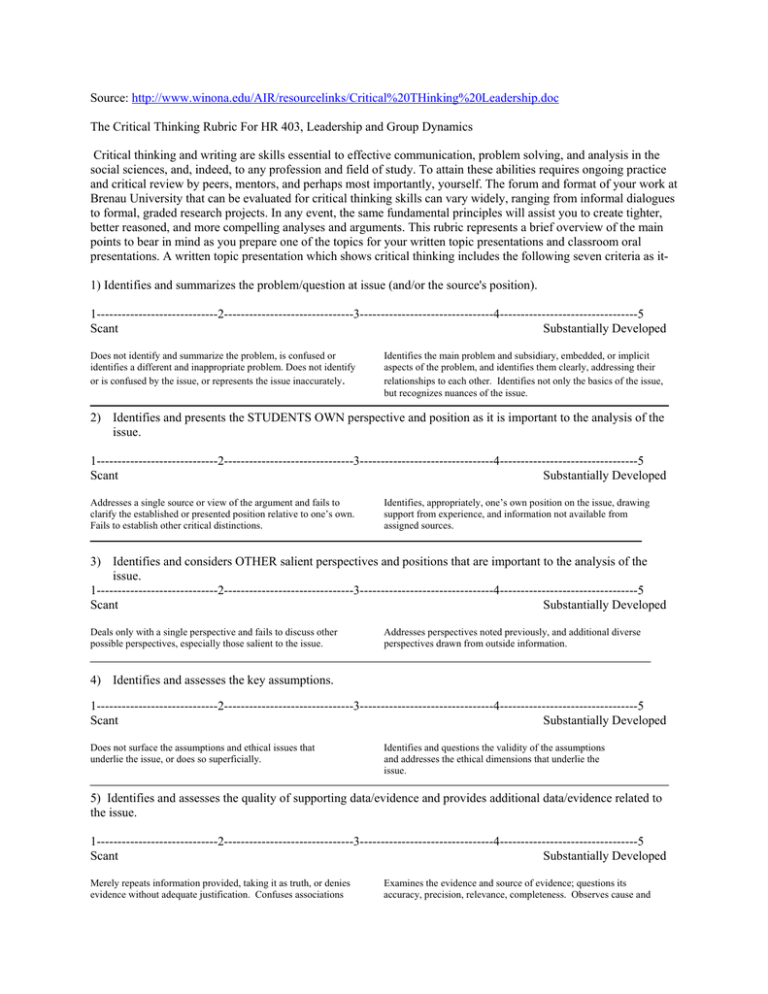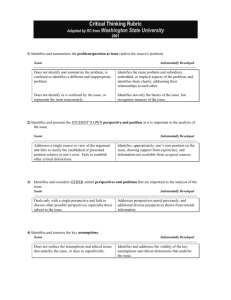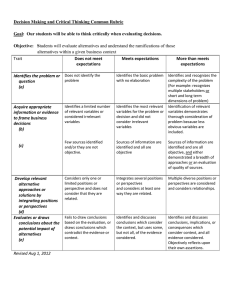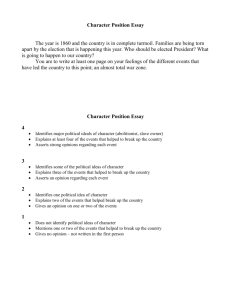Source: The Critical Thinking Rubric For HR 403, Leadership and Group... Critical thinking and writing are skills essential to effective communication,...
advertisement

Source: http://www.winona.edu/AIR/resourcelinks/Critical%20THinking%20Leadership.doc The Critical Thinking Rubric For HR 403, Leadership and Group Dynamics Critical thinking and writing are skills essential to effective communication, problem solving, and analysis in the social sciences, and, indeed, to any profession and field of study. To attain these abilities requires ongoing practice and critical review by peers, mentors, and perhaps most importantly, yourself. The forum and format of your work at Brenau University that can be evaluated for critical thinking skills can vary widely, ranging from informal dialogues to formal, graded research projects. In any event, the same fundamental principles will assist you to create tighter, better reasoned, and more compelling analyses and arguments. This rubric represents a brief overview of the main points to bear in mind as you prepare one of the topics for your written topic presentations and classroom oral presentations. A written topic presentation which shows critical thinking includes the following seven criteria as it1) Identifies and summarizes the problem/question at issue (and/or the source's position). 1-----------------------------2-------------------------------3--------------------------------4---------------------------------5 Scant Substantially Developed Does not identify and summarize the problem, is confused or identifies a different and inappropriate problem. Does not identify or is confused by the issue, or represents the issue inaccurately. Identifies the main problem and subsidiary, embedded, or implicit aspects of the problem, and identifies them clearly, addressing their relationships to each other. Identifies not only the basics of the issue, but recognizes nuances of the issue. 2) Identifies and presents the STUDENTS OWN perspective and position as it is important to the analysis of the issue. 1-----------------------------2-------------------------------3--------------------------------4---------------------------------5 Scant Substantially Developed Addresses a single source or view of the argument and fails to clarify the established or presented position relative to one’s own. Fails to establish other critical distinctions. Identifies, appropriately, one’s own position on the issue, drawing support from experience, and information not available from assigned sources. 3) Identifies and considers OTHER salient perspectives and positions that are important to the analysis of the issue. 1-----------------------------2-------------------------------3--------------------------------4---------------------------------5 Scant Substantially Developed Deals only with a single perspective and fails to discuss other possible perspectives, especially those salient to the issue. Addresses perspectives noted previously, and additional diverse perspectives drawn from outside information. 4) Identifies and assesses the key assumptions. 1-----------------------------2-------------------------------3--------------------------------4---------------------------------5 Scant Substantially Developed Does not surface the assumptions and ethical issues that underlie the issue, or does so superficially. Identifies and questions the validity of the assumptions and addresses the ethical dimensions that underlie the issue. 5) Identifies and assesses the quality of supporting data/evidence and provides additional data/evidence related to the issue. 1-----------------------------2-------------------------------3--------------------------------4---------------------------------5 Scant Substantially Developed Merely repeats information provided, taking it as truth, or denies evidence without adequate justification. Confuses associations Examines the evidence and source of evidence; questions its accuracy, precision, relevance, completeness. Observes cause and and correlations with cause and effect. Does not distinguish between fact, opinion, and value judgments. effect and addresses existing or potential consequences. Clearly distinguishes between fact, opinion and acknowledges value judgements. 6) Identifies and considers the influence of the contexts* on the issue. 1-----------------------------2-------------------------------3--------------------------------4---------------------------------5 Scant Substantially Developed Discusses the problem only in egocentric or sociocentric terms. does not present the problem as having connections to other contexts. Analyzes the issue with a clear sense of scope and context, including an assessment of the audience of the analysis. Considers other pertinent contexts. 7) Identifies and assess conclusions, implications and consequences. 1-----------------------------2-------------------------------3--------------------------------4---------------------------------5 Scant Substantially Developed Fails to identify conclusions, implications, and consequences of the issue or the key relationships between the other elements of the problem, such as context, implications, assumptions, or data and evidence. Identifies and discusses conclusions, implications, and consequences considering context, assumptions, data, and evidence. Objectively reflects upon their own assertions. *Contexts for consider: cultural/social, scientific, educational, economic, technological, ethical, political, personal experience.




